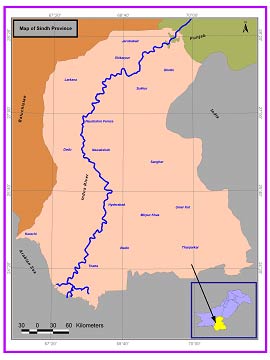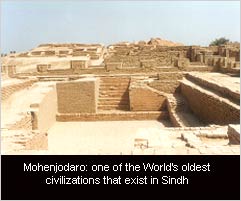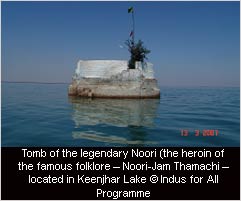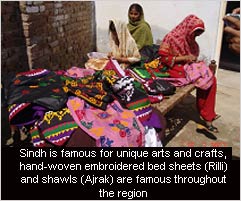
 Sindh, derives its name from the River Indus, which in ancient times was known as Sindhudesh, Sindhu being the original name of the River and desh meaning territory.
Sindh, derives its name from the River Indus, which in ancient times was known as Sindhudesh, Sindhu being the original name of the River and desh meaning territory.
Sindh was the hub of the great Indus Valley Civilization, which can be traced back to around third millennium BC. The Civilization with a population of nearly half a million had well-planned grid cities and sewer systems. Trade activities took place between the Indus Valley Civilization and ancient Mesopotamia and Egypt via established shipping routes. In ancient Egypt, the word for cotton was Sindh suggesting that the bulk of cotton at the time was imported from the Indus Valley Civilization.
The province has enjoyed a rich and eventful history. It was invaded by Alexander the Great in 325 BC. The first Muslim invader of the sub-continent, Muhammad Bin Qasim invaded Sindh in 712 AD, making Sindh an important foothold for Muslims. For the next three centuries the area remained under direct or indirect control of the Arabs. In 1592 Mughals seized control of the region and it remained part of the Mughal empire until the 18th century when it reverted back to the rule of the local dynasties. In 1843 with the British invasion of the sub-continent the province became part of the Bombay presidency. In 1937, due to the efforts of the Muslims, it became a governor’s province and upon partition in 1947 it became part of Pakistan. In 1948 Karachi, the provincial capital was detached and Hyderabad became the provincial capital. In 1955 Sindh was merged with other provinces to form West Pakistan but in 1970 the former borders were restored.
Source: Collier’s Encyclopedia

Sindh is the second most populous province in Pakistan. With a growth rate of 2%, total population is estimated at 34.231 million across 18 districts (and now 22 districts in 2008). The Indus for All Programme is concentrated in three of these districts: Keti Bunder, District Thatta; Keenjhar Lake, District Thatta; Chotiari District Sanghar; and, Pai Forest, District Nawabshah. A comparative demographic profile of the three districts vis-à-vis the entire province is presented as under:
|
Sindh
|
Nawabshah
|
Sanghar
|
Thatta
|
Area (sq km) |
140914 |
4239 |
10728 |
17355 |
Total Population |
34.231 |
1135131 |
1452956
|
1113194
|
Male |
18.005 |
599275 |
762212
|
589341
|
Female |
16.226 |
535856 |
690744
|
523853
|
Population Density (per sq km) |
243 |
240 |
135.04
|
64.1 |
Growth Rate (%) |
2 |
3.09 |
2.74 |
2.26 |
Average Household Size |
6 |
6 |
- |
5.1 |
| Source: Population Welfare Department, Government of Sindh | ||||
According to a baseline assessment conducted by WWF, around 50% of the population in the Indus for All Programme sites is aged 15 years and under. Population over the age of 60 is only 3%, indicating low standard of health and sanitation facilities. Further, prevalence of diseases like malaria, diarrhea, and skin diseases is quite common and the provision of public health services is negligible except for in the area around Keti Bunder.
Professional maternity services are also not available in the programme areas. The baseline assessment revealed that more than 76% births are attended by local Dai (Traditional Birth Attendants), while only about 1% births are handled by trained Lady Health Visitors. As for private clinics and public hospitals, they account for 12% and 9% of child births cases respectively. Infant mortality has been reported at 7% while mother’s death at childbirth is estimated at 1%.
The average per capita monthly income in the Indus for All Programme’s sites has been estimated at Rs. 1,205 only. The highest average income (Rs. 1,520) has been reported for Keti Bunder and the lowest for Keenjhar (Rs. 971). More than half (51.2%) of the households are categorized as poor. While Keti Bunder has the least number of poor households, the standard of living is quite low. Majority of the income of inhabitants of the area is reportedly spent on purchase of water and transportation through boats.
Strong indication of gender bias with respect to division of labour is also evidenced in these areas. While women make significant contribution in the economic sphere, their work often goes unrecognized. On an average, women get paid 50% less than men, and have little, if any, control over resources and limited role in decision making.
Education being a key development indicator is far from promising. Ninety percent of the population aged 15 years and above is illiterate and there is significant gender disparity with respect to access to education. Overall literacy figures for each district show the highest literacy rate for District Nawabshah estimated at 34.13%, followed by Sanghar at 30.87% and Thatta at 30.4 .
Sindhi society being traditionally conservative in nature, has limited role for women outside the home. Young girls have mobility restrictions and are required to observe ‘purdah’ (veil). Normally they stay home and look after their younger siblings and help in household chores. Early marriages are also quite common. The minimum marital age for girls has been reported at 7 years, while that for boys is 10 years. Decisions pertaining to marriage are normally made by parents or elders and in some cases the fate of the female offspring is decided even before birth.

Sindh, due to its relative geographical isolation from the rest of the provinces, has formed its own unique culture. It is rich in arts, music, poetry and literature.
The Sindhi language is a derivate of Sanskrit and is closely related to the ancient Prakrit. It is the official language of the province of Sindh and the second most spoken language in Pakistan.
Sindh is home to two world heritage sites, Mohenjodaro which lies on the right bank of Indus in Larkana district and Makli, in Thatta district. Further, cities like Thatta, Shikarpur, Sukku, Bukku, Rohri and Hyderabad contain some of the most beautiful buildings and old tombs in the country, which are evidence of the rich history of the province.
The people of Sindh are skilled in a variety of arts and crafts. The province boasts of exquisite pottery, variegated glazed tiles, lacquer-work, hand-woven textiles like susi and ajrak and a variety of leather and straw products.
There are a number of folk festivals that are part of the Sindhi culture. An important fisher-folk festival is held annually at the tomb of Haji Ibrahim in the Shah Bunder taluka in Thatta district. Another popular festival is the Urs (death anniversary) of Shahbaz Qalandar at Sehwan. Shahbaz Qalandar was a renowned saint, whose devout followers include names like Shah Abdul Latif Bhitai, Makhdoom Bilawal, Sachal Sarmast and Qadir Bukhsh Bedal.
Traditional sports are Bitharo, a local form of baseball, Gili Dakar (similar to tipcat) and Tisi, which is a form of hopscotch. For the elite, favourite pass times include falconry, hunting and horse riding.

The livelihood of the people living around the IFAP sites has been heavily dependent on natural resources. Most people are engaged in primary sectors of production such as agriculture and fishing or in labor intensive occupations.
For majority of the people residing around Keti Bunder, Keenjhar and Chotiari, fishing is the main source of income. This is followed by farming or agricultural activities either on their own land or as farm labor. In Pai Forest, the majority is involved in agricultural activities followed by livestock farming. Traditionally majority of the people were engaged in cattle farming but over the years due to reduction in water resources, pastures and forests, agricultural activities have gained prominence in this site. A small proportion of the population in Chotiari and Keenjhar sites are also involved in livestock farming.
However, over the years the people in these areas have been facing substantial loss of incomes due to depletion/degradation of natural resources. This has been mainly as a result of mismanagement of natural resources which includes factors such as:
Illegal hunting of wildlife
Invasive species
Encroachment over natural biota
Lack of good governance
Lack of awareness about wise use of natural resources
Ill-managed protected areas
Soil degradation
Lack of a sense of ownership
Encroachment of forest lands
Over-exploitation of fisheries
As a result of the above people have been forced to seek alternative means of livelihood and local women have taken to craft production, embroidery, weaving fishing nets, collecting wild grass and so forth to supplement household income However, in most cases families have had to resort to selling their livestock or obtaining loans, which has further pushed them down the poverty spiral.
|